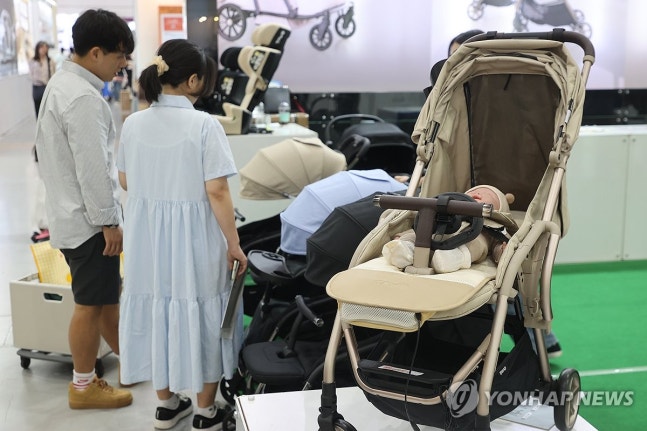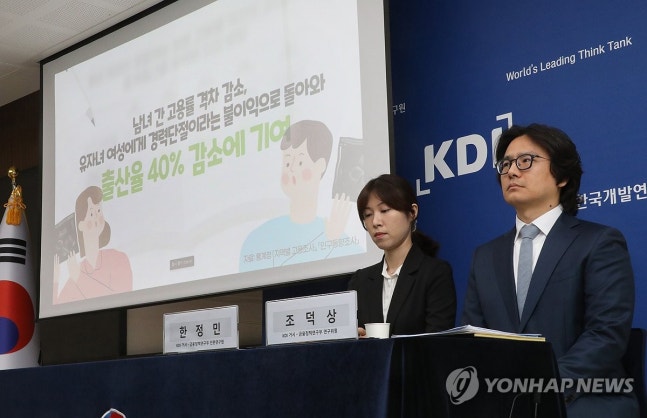IMF: Economic Growth and Fertility Rates Improving by Narrowing Gender Gaps in Korea and Japan,
,
,

All baby products in one place
(Seoul=Yonhap News) Reporter Ryu Hyo-rim = Visitors looking at baby products at the overseas Kobe Baby Fair held at COEX in Samseong-dong, Gangnam-gu, Seoul on the 28th. 2024.4.28 [email protected],
,
, ” (Sejong=Yonhap News) Reporter Song Jeong-eun = Multiple studies have recently pointed out that in South Korea, where child-rearing responsibilities are mostly placed on women, there is a negative relationship between women’s economic activity and childbirth.”
,
, ‘ The International Monetary Fund (IMF) recently stated that “balancing women’s work and family life is particularly difficult” in South Korea and Japan, suggesting that flexible working hours and shared household chores should be promoted to establish a virtuous cycle in which women’s economic activities contribute to economic growth and address low birth rates.’,
,
, ” According to a report on ‘Birth Gap by Economic and Social Factors’ published by the Statistics Development Institute on the 27th, it was found that women in households where both spouses are working or in dual-income households tend to have fewer children compared to households where one spouse is not working.”,
,
, ‘ Researchers (Woo Han-soo and Shim Soo-jin, officials at the Statistics Development Institute) analyzed the correlation between factors such as income and economic activity status of households with spouses aged 25-44 using household trend surveys over the past 20 years (2003-2023).’,
,
, ‘ As of last year, the number of children in dual-income households was 1.36, which was lower than that in non-dual-income households (1.46).’,
,
, ‘ In particular, in the high-income bracket, the difference in the number of children between non-dual-income (1.75) and dual-income (1.43) households was 0.32. Conversely, in the 1st to 2nd income brackets, the number of children in dual-income households was slightly higher.’,
,
, ‘ The researchers analyzed that in the low-income bracket, there is a high possibility of dual-income households having more children due to not being able to use childcare leave for childcare and child-rearing for economic reasons, etc.’,
,
, ‘ The same trend was observed when examining by women’s economic activity.’,
,
, ‘ The number of children in non-working households (1.48) was 0.27 higher than that in working households (1.34). In the highest income bracket, this difference was 0.34.’,
,
, ‘ Regression analysis based on the data showed that the coefficient of women’s income last year was -0.04, indicating a negative correlation between the number of children and women’s income. When women’s income increases by 100%, the number of children decreases by approximately 4%.’,
,
, ‘ In contrast, men’s income showed a positive correlation with the number of children.’,
,
, ‘ The researchers emphasized the need to ensure the continuity of careers through measures such as parental leave rather than career interruptions for women to have children.’,
,
,

Concerns about women’s career interruptions and declining birth rates
(Sejong=Yonhap News) Reporter Bae Jae-man = Jo Deok-sang, a research fellow at the KDI Macroeconomic and Financial Policy Research Department (right), and Han Jeong-min, a senior researcher at KDI, are briefing on ‘KDI Focus: Concerns about women’s career interruptions and declining birth rates’ at the Sejong government building on the 16th. 2024.4.16 [email protected],
,
, ” The Korea Development Institute (KDI) recently revealed that employment disadvantages such as ‘child penalties’ resulting from career interruptions, a representative cause of declining birth rates from 2013 to 2019, account for about 40%.”,
,
, ‘ According to the study, the average career interruption rate of women in their 30s has steadily decreased but mainly focused on cases without children.’,
,
, ‘ Fundamentally, this is due to the fact that child-rearing and caregiving are largely skewed towards women in South Korea.’,
,
, ‘ According to the OECD and KDI, South Korea ranks behind Japan (18%) and Turkey (22%) with a 23% ratio of unpaid labor hours for men compared to women, which indicates the level of men’s engagement in household activities. The OECD average is 52%, more than twice that of South Korea.’,
,
, ” The IMF, in its ‘Focus’ report released on the 21st on South Korea and Japan, pointed out the reality where women face delayed career advancement, household chore issues after marriage and childbirth. This has led to a prevalence of late marriages and births, significantly affecting the decline in birth rates.”,
,
, ‘ The IMF mentioned that women in South Korea and Japan perform five times more unpaid household chores and caregiving than men, analyzing that the social norms in both countries place a burden on women. ‘,
,
, ” Additionally, due to the ‘dual structure of the labor market,’ many female workers in South Korea are working in low-paying temporary positions or part-time jobs, and the working hours and work styles are not family-friendly, with long working hours and restrictions on remote work, it added.”,
,
, ‘ The IMF advised promoting job mobility to support women’s employment and career growth opportunities. Suggestions included expanding daycare facilities, incentivizing husband’s use of paternity leave, improving men’s participation in childcare, and expanding remote work and flexible working hours.’,
,
, ‘ It was believed that the increase in women’s economic participation contributes to economic growth and could also help to reverse the decline in birth rates by narrowing gender gaps and changing cultural norms.’,
,
, ‘ The IMF stated, “If South Korea reduces the gap in working hours between men and women to the OECD average by 2035, it could increase GDP per capita by 18%” and emphasized that “empowering women in South Korea and Japan to pursue fulfilling careers while starting families can ultimately make significant contributions to the economy and society.”‘,
,
, ‘ [email protected]’,
,
,

